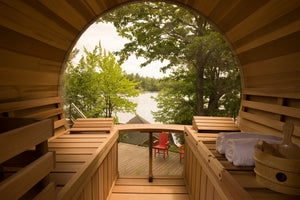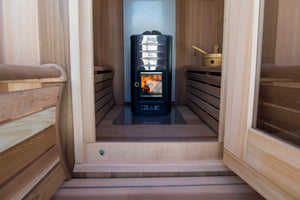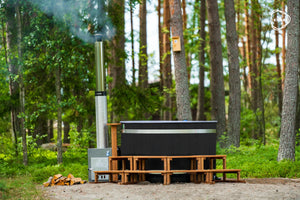Using a sauna in winter isn’t just about staying warm, it’s about supporting your health during the coldest months of the year. Winter brings cold weather and shorter days but also offers the perfect opportunity to enjoy a sauna.
The contrast between the chilly air outside and the warm, cozy environment inside a sauna creates a unique and refreshing experience. Using a sauna in winter can boost our immune system, reduce stress, and provide a much-needed escape from the cold.
We often need to stay indoors and hibernate during the colder months. A sauna session allows us to shed our heavy winter clothes and relax in a warm, soothing space. It's a great way to fight the winter blues and renew our energy. After spending time in the heat, stepping back into the cool air feels invigorating and can help us appreciate the season's beauty.
Saunas also offer comfort and relief for sore muscles after winter activities like skiing or shoveling snow. The heat helps our bodies recover and eases any tension we might be carrying. It's a simple yet effective way to care for ourselves when we're more prone to feeling run down or sick.
This guide covers the seasonal advantages of sauna use, practical safety tips, and how to make winter saunas a restorative part of your wellness routine.
Here's what you'll learn:
-
Health and wellness benefits of sauna sessions in winter
-
Sauna use after winter sports: Recovery and performance
-
Mental and cultural benefits of winter sauna traditions
-
How to get the most from your winter sauna sessions
Let's dive in.
Health and wellness benefits of sauna sessions in winter
Sauna sessions in winter offer many health perks. This section will focus on how they boost immunity, improve blood flow, help with sleep and stress, and benefit skin health.
How winter saunas support your immune system
Saunas can help our bodies fight off winter illnesses, as the heat raises our body temperature, like a fake fever. This kicks our immune system into gear. Furthermore, sauna use increases white blood cell counts. These cells are key defenders against germs, and regular sauna sessions may lead to fewer colds and flu cases.
Heat also helps make protective proteins in our bodies. These proteins, called heat shock proteins, help our cells work better. This can make our immune system stronger over time.
Sauna effects on circulation in cold weather
Sauna heat makes our heart pump faster, and our blood vessels open up. This leads to better blood flow all over our body. Better circulation brings more oxygen to our muscles and organs. It can ease sore muscles and joint pain from cold weather. Improved blood flow may also lower blood pressure for some people.
The heat-then-cool cycle of a sauna session is beneficial for our blood vessels. It helps them stay flexible, which is good for heart health in the long run.
Saunas for better sleep and winter stress relief
Saunas can help us relax and sleep better in winter, as the heat helps our bodies create endorphins. These are feel-good chemicals that help us calm down. After a sauna, our body temperature also drops. This drop in temperature can help us fall asleep faster and sleep more deeply. Additionally, sauna time is a break from phones and screens, and this quiet can help clear our minds and lower stress levels.
Detoxification and skin health
Sweating in a sauna helps clean our skin. It opens up pores and washes away dirt and old skin cells, leading to clear, fresher-looking skin. This extra blood flow also brings nutrients that keep the skin healthy. It might help our skin look younger and feel softer.
Sauna sweating may help our bodies get rid of some toxins. While our liver and kidneys do most of the detox work, some studies show that sweating can help, too. This could be extra helpful in winter when we're less active.
Sauna use after winter sports: Recovery and performance
Winter sports like skiing, snowboarding, and snowshoeing place heavy demands on muscles and joints. Post-activity sauna sessions offer a natural way to accelerate recovery and reduce fatigue. The heat helps dilate blood vessels, increasing circulation and promoting faster removal of metabolic waste like lactic acid.
When used after cold-weather exertion, saunas can relax tense muscles and reduce soreness. The warm environment also supports joint flexibility, especially useful for those dealing with stiffness from repeated exposure to cold or impact. Infrared saunas, in particular, penetrate deep into tissue and may help ease inflammation in overworked areas.
According to a 2018 study published in Evidence-Based Complementary and Alternative Medicine, sauna bathing following exercise can reduce muscle soreness and enhance perceived recovery without negative impacts on cardiovascular health. For winter athletes or active homeowners shoveling snow, integrating sauna into your routine can significantly aid performance and post-exertion comfort.
Mental and cultural benefits of winter sauna traditions
Winter saunas offer more than just physical benefits. They provide mental and social wellness, too. Saunas have deep cultural roots in cold climates and can help fight winter blues.
Sauna traditions in cold-weather cultures
Saunas have been part of life in cold regions for centuries. In Finland, they're seen as a second home, and families gather in saunas to relax and bond. The warmth of a sauna contrasts with the cold outside. This creates a cozy feeling that lifts spirits.
Many cultures even use saunas for important events and rituals. In Russia, the banya is a place for cleansing the body and mind. Swedes often use saunas before a refreshing dip in icy water. These practices connect people to their heritage and nature.
Practicing mindfulness and relaxation in the sauna
Saunas provide a perfect setting for mindfulness. The quiet, warm space helps us focus on the present moment, and practice deep breathing or meditation while we sweat. The heat relaxes tense muscles, easing physical and mental stress.
This makes it easier to let go of worries and clear our minds. Some people use visualizations in the sauna. They might picture the heat melting away their stress, while others focus on the sensations in their body as they relax.
Can sauna use help with seasonal affective disorder (SAD)?
Winter can bring low moods and energy levels. This is often due to Seasonal Affective Disorder (SAD). Saunas can help fight these winter blues in several ways. The warm light in a sauna can mimic sunlight. This may help regulate our body's natural rhythms.
Plus, sweating releases endorphins, which are natural mood boosters. These benefits can help offset the effects of shorter, darker days. Many people find that saunas give them a mental lift during winter.
Saunas as winter gathering spaces and social rituals
Saunas can be social spaces that bring people together. In many cultures, sauna time is shared with family and friends. This social aspect is especially valuable in winter when we might feel isolated.
Group sauna sessions can foster:
-
Deeper conversations
-
Stronger bonds
-
A sense of community
Some people host "sauna parties" as winter social events. These gatherings combine warmth, relaxation, and companionship. They offer a chance to connect without the distractions of everyday life. Sharing a sauna experience can create lasting memories and traditions. It's a way to make the most of winter's indoor time with others.
How to get the most from your winter sauna sessions
Winter is a great time to enjoy saunas. We'll share tips to maximize your sauna sessions during the cold months.
Best sauna types for winter use
Infrared saunas are a good choice for home use because they heat up quickly and use less energy than traditional saunas. Meanwhile, outdoor saunas offer a unique experience, letting you enjoy nature while staying warm.
We suggest getting a well-insulated model for outdoor saunas, as this helps keep the heat in and saves energy. Home saunas can be installed in a spare room or basement, but always ensure there's good ventilation.
Traditional Finnish-style saunas use hot rocks and steam, creating a very hot, humid environment. Infrared saunas use light waves to heat your body directly. They're usually not as hot as traditional saunas.
Winter sauna prep and safety best practices
Before using a sauna, drink water to stay hydrated, and wear loose, comfortable clothing that's easy to remove. Bring a towel to sit on and wipe off sweat.
Check the sauna temperature before entering. Most people find 150-175°F (65-80°C) comfortable. Start with shorter sessions, like 10-15 minutes. You can slowly increase the time as you get used to it.
Don't use the sauna if you're sick or have been drinking alcohol. Pregnant women and people with certain health conditions should talk to a doctor first. Always listen to your body. If you feel dizzy or uncomfortable, leave the sauna right away.
How to cool down safely after a winter sauna
After your sauna session, it's essential to cool down slowly. Step outside and breathe in the crisp winter air. Then, take a cool shower to rinse off sweat and lower your body temperature. If you're brave, try a quick roll in the snow! This is a Finnish tradition that can be fun and invigorating.
Drink water or a sports drink to replace fluids lost through sweating, and avoid alcohol, as it can make you more dehydrated. Rest for a bit before getting dressed. This lets your body temperature return to normal.
Can cold plunges after sauna improve winter wellness?
The combination of sauna heat followed by cold exposure, known as contrast therapy, is a centuries-old practice in Nordic cultures. In winter, stepping into snow or a cold plunge after a sauna session intensifies the body’s adaptive response, improving circulation and mental resilience.
The sharp temperature shift causes blood vessels to constrict quickly after dilation in the sauna. This “vascular workout” can enhance cardiovascular flexibility and improve oxygen delivery throughout the body. Cold exposure also triggers the release of norepinephrine, a hormone linked to alertness and mood regulation, helping combat winter sluggishness and symptoms of Seasonal Affective Disorder.
Research from PLOS One (2014) suggests that regular cold exposure may lower inflammation and improve tolerance to cold stress. However, cold plunges are not for everyone.
People with heart conditions or uncontrolled blood pressure should consult a healthcare provider before attempting thermal contrast. When done safely, this ritual can elevate winter sauna sessions into a powerful tool for physical and emotional resilience.
Making sauna sessions part of your winter wellness routine
We suggest using the sauna 2-3 times weekly for best results. Try combining sauna sessions with other activities, such as after a workout to help soothe sore muscles. Or use it before bed to relax and improve sleep.
Keep a log of your sauna sessions. Note how you feel before and after, as this can help you track benefits over time. Remember, consistency is key. Make regular saunas part of your routine to get the most health benefits.
Conclusion
Winter presents unique stressors on the body, colder temperatures, reduced daylight, and lower activity levels can all impact physical and mental health. Regular sauna use in this season offers a natural way to counterbalance these effects. It enhances circulation, supports immune function, improves sleep quality, and promotes mood regulation through heat-induced endorphin release.
For those engaged in winter sports or exposed to cold-related muscle strain, saunas also offer a therapeutic recovery tool by increasing blood flow and relaxing tense tissue. Culturally, saunas remain a timeless refuge during long winters, providing warmth, connection, and reflection.
By integrating sauna sessions into your weekly routine, you’re not just escaping the cold, you’re building resilience. And with options like infrared and traditional setups, it’s possible to create a restorative winter wellness ritual at home. For expert guidance and custom solutions, contact Finnish Sauna Builders to design a sauna that meets your lifestyle and health goals.
Get in touch to discuss possible sauna options in your home, and learn more about the possible benefits of regular sauna use.





